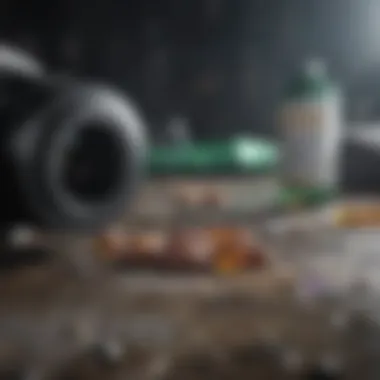Guidelines for Proper Disposal of Liquid Medical Waste: A Comprehensive Overview


Overview of the Topic
Liquid medical waste disposal is a critical aspect of healthcare waste management that demands meticulous attention. The significance of this topic lies in mitigating environmental and health risks associated with improper waste disposal practices within healthcare facilities. Understanding the various types of liquid medical waste and implementing safe and eco-friendly disposal methods are paramount for safeguarding public health and environmental integrity.
Current Status and Challenges
The current state of liquid medical waste disposal poses significant challenges due to the complexities involved in handling biohazardous materials safely. Healthcare facilities often face hurdles in adhering to strict regulations and guidelines for waste disposal, leading to potential environmental contamination and health hazards. The lack of standardized protocols and awareness further exacerbates the issue, highlighting the urgent need for sustainable solutions.
Sustainable Solutions
Exploring sustainable practices in liquid medical waste management is crucial for promoting environmental sustainability and public safety. Implementing effective segregation of liquid waste at the source, utilizing efficient treatment technologies such as autoclaving or chemical disinfection, and fostering a culture of waste reduction and recycling are key components of sustainable waste management strategies. By showcasing successful case studies and innovative approaches, healthcare providers can inspire industry-wide adoption of best practices.
Impact and Importance
The impact of proper liquid medical waste disposal reverberates across ecosystems, communities, and future generations, underscoring the interconnectedness of environmental health and human well-being. Inadequate waste management can lead to soil and water contamination, endangering biodiversity and public health. Recognizing the critical importance of conservation efforts and sustainable resource use is essential for preserving natural resources and safeguarding global health for generations to come.
Introduction
In the realm of healthcare waste management, the proper disposal of liquid medical waste stands paramount. This section serves as a cornerstone, shedding light on the nuances and criticalities associated with managing liquid medical waste effectively. From identifying the various types of liquid medical waste to exploring the risks linked to improper disposal, this introductory segment sets the stage for a comprehensive understanding of the topic.
Understanding Liquid Medical Waste
Definition of Liquid Medical Waste
Delving into the definition of liquid medical waste unveils its core essence within the healthcare landscape. Liquid medical waste comprises substances like blood, bodily fluids, or any materials contaminated with potentially infectious agents. This definition encapsulates the hazardous nature of these wastes, necessitating meticulous handling and disposal protocols to prevent the spread of infections. Understanding this definition is fundamental in recognizing the gravity of managing liquid medical waste for the safety of healthcare workers, patients, and the environment.
Types of Liquid Medical Waste
Exploring the various types of liquid medical waste reveals a spectrum of materials that demand specialized disposal strategies. From expired medications to laboratory reagents, each type poses unique challenges in terms of containment and disposal. Recognizing these distinct categories empowers healthcare facilities to tailor their waste management approach according to the specific characteristics and risks associated with each type. This section elucidates the diversity within liquid medical waste, emphasizing the need for targeted disposal measures based on individual waste streams.
Risks Associated with Improper Disposal
Environmental Impact
The improper disposal of liquid medical waste can trigger far-reaching environmental consequences, jeopardizing ecosystems and public health. Chemical contaminants from unmanaged waste can infiltrate soil and water sources, leading to bioaccumulation and ecological disruptions. Addressing the environmental impact is critical not only for preserving natural habitats but also for mitigating the potential health hazards that stem from contaminated environmental reservoirs.


Health Risks
Mishandling liquid medical waste poses direct health risks to individuals coming into contact with these hazardous materials. Exposure to infectious agents or toxic substances harbored in improperly disposed waste can result in severe health complications, ranging from skin infections to respiratory ailments. Understanding these risks underscores the urgent need for stringent waste management protocols to safeguard public health and prevent disease transmission.
Regulations and Guidelines
OSHA Regulations
The Occupational Safety and Health Administration (OSHA) imposes stringent regulations on managing liquid medical waste to safeguard the well-being of healthcare personnel and the community. These regulations outline specific guidelines for waste segregation, containment, and disposal, ensuring compliance with OSHA standards is imperative for healthcare facilities to uphold a safe working environment and prevent regulatory penalties. Adhering to OSHA regulations not only promotes workplace safety but also fosters a culture of responsibility towards waste management practices.
EPA Guidelines
The Environmental Protection Agency (EPA) provides comprehensive guidelines for the handling and disposal of hazardous waste, including liquid medical waste. These guidelines aim to minimize environmental pollution and protect public health by promoting safe and sustainable waste management practices. Healthcare facilities acquainted with EPA guidelines can navigate the complexities of waste disposal with precision, aligning their operations with environmental conservation goals and regulatory requirements.
Handling and Segregation
In the realm of liquid medical waste management, the section on Handling and Segregation is of paramount importance. This crucial stage ensures that hazardous materials are managed effectively to avoid adverse environmental and health impacts. By focusing on proper handling techniques and segregation practices, healthcare facilities can minimize risks and streamline waste management processes. Implementing robust protocols for handling and segregation can enhance workplace safety, regulatory compliance, and overall operational efficiency.
Best Practices for Handling
Proper Storage
Proper storage plays a pivotal role in maintaining the integrity and safety of liquid medical waste. It involves storing waste materials in designated containers or areas that are specifically designed to prevent leaks, spills, and potential contamination. The key characteristic of proper storage lies in its ability to isolate hazardous waste from the surrounding environment, reducing the risk of exposure to harmful pathogens or chemicals. Properly stored waste minimizes the likelihood of accidents, promotes organizational hygiene, and facilitates easy monitoring and disposal processes. While proper storage is a standard practice in healthcare facilities, continuous adherence to storage guidelines is crucial to uphold safety standards and regulatory requirements.
Labeling Requirements
Labeling requirements serve as vital markers for identifying and categorizing different types of liquid medical waste. Properly labeled containers provide essential information such as waste contents, collection dates, potential hazards, and disposal protocols. Clear and accurate labeling contributes to efficient waste management by ensuring that waste handlers can easily recognize, handle, and segregate waste streams according to designated categories. Moreover, labeling requirements help prevent mix-ups, improve traceability, and support compliance with regulatory guidelines. While labeling may seem like a routine task, it plays a fundamental role in ensuring the safe and systematic disposal of liquid medical waste.
Segregation Techniques
Color-Coding
Color-coding is a visual segregation technique that simplifies the categorization and sorting of liquid medical waste. By assigning specific colors to different waste streams or containers, healthcare facilities can visually differentiate between hazardous materials, sharps, pharmaceutical waste, and other categories. The key characteristic of color-coding lies in its ability to enhance waste segregation accuracy, reduce confusion, and streamline collection and disposal processes. Color-coded systems also enable quick identification of waste types, promote proper handling practices, and mitigate the risk of improper disposal. While color-coding facilitates operational efficiency and waste management compliance, careful implementation and maintenance of color-coded systems are necessary to ensure effectiveness and consistency.
Segregation Based on Type
Segregation based on type involves categorizing liquid medical waste according to its specific characteristics, composition, or source. By segregating waste streams based on their properties or contamination levels, healthcare facilities can tailor disposal methods to suit the unique requirements of each waste category. This targeted approach ensures that different types of waste are treated, stored, and disposed of in a manner that minimizes risks and maximizes resource recovery opportunities. Implementing segregation based on type promotes waste reduction, aids in recycling efforts, and optimizes operational workflows within healthcare settings. While segregation can enhance sustainability and waste management outcomes, proper identification, classification, and segregation of waste streams are essential for achieving regulatory compliance and environmental stewardship.


Treatment and Disposal Methods
The Treatment and Disposal Methods section of this article plays a pivotal role in enlightening readers on the significance of proper handling and disposal techniques for liquid medical waste. In the healthcare sector, the safe and efficient management of liquid medical waste is critical to prevent environmental contamination and safeguard public health. By outlining the essential procedures and methods for treating and disposing of liquid medical waste, this section aims to equip individuals and healthcare professionals with the necessary knowledge to adhere to best practices and regulations in waste management.
Disinfection Procedures
Chemical Disinfection
Chemical disinfection is a key aspect of the Treatment and Disposal Methods, serving as a fundamental technique in rendering harmful pathogens inert within liquid medical waste. The utilization of chemical agents like chlorine-based solutions or peracetic acid contributes significantly to the decontamination process, ensuring that the waste is safe for subsequent handling and disposal. The distinct feature of chemical disinfection lies in its ability to swiftly neutralize infectious agents, making it a preferred choice for environments where efficiency and rapid disinfection are imperative. While chemical disinfection offers swift and effective pathogen eradication, it is essential to note the potential hazards and safety protocols associated with handling these chemical agents.
Autoclaving
Autoclaving stands out as an indispensable method in the Treatment and Disposal Methods, providing a reliable approach to sterilizing liquid medical waste through high-pressure steam treatment. The key characteristic of autoclaving lies in its ability to achieve high-level disinfection by subjecting the waste to elevated temperatures and pressures, effectively destroying infectious microorganisms. This method is favored for its efficacy in rendering waste safe for disposal, especially in healthcare settings where thorough sterilization is paramount. Despite its efficacy, autoclaving may have drawbacks such as energy consumption and the need for specialized equipment, which should be considered when evaluating its suitability for waste management practices.
Safe Disposal Options
Incineration
Incineration emerges as a prominent safe disposal option for liquid medical waste, contributing significantly to the overall waste management process. The key characteristic of incineration lies in its ability to thermally decompose waste materials at high temperatures, reducing them to ash and gases. This method is favored for its ability to eliminate pathogens and reduce the waste volume significantly, making it a viable choice for disposing of hazardous medical waste. However, considerations regarding air emissions and compliance with environmental regulations are crucial factors to address when opting for incineration as a disposal method.
Off-Site Treatment Facilities
Off-site treatment facilities offer a practical solution for the safe disposal of liquid medical waste, allowing healthcare facilities to transfer their waste to specialized facilities equipped to handle treatment and disposal procedures. The key characteristic of off-site treatment facilities lies in their capacity to process bulk quantities of medical waste efficiently while adhering to stringent regulations. This option is advantageous for healthcare facilities that may lack the resources or infrastructure to manage waste disposal internally. Despite its benefits, logistics and transportation considerations must be carefully managed to ensure the safe and compliant disposal of liquid medical waste.
Recycling Possibilities
Reuse of Treated Waste
The reuse of treated waste presents an innovative approach to sustainable waste management, allowing for the safe utilization of processed liquid medical waste in various applications. The key characteristic of reusing treated waste lies in its potential to reduce environmental impact and promote resource efficiency by repurposing sterilized liquids for irrigation or industrial purposes. This method offers a valuable avenue for minimizing waste generation and promoting circular economy principles within the healthcare sector. However, stringent quality control procedures and regulatory compliance are essential to ensure the safety and efficacy of reusing treated waste.
Recovery of Resources
The recovery of resources from liquid medical waste underscores the importance of harnessing valuable materials and energy sources through advanced treatment technologies. The key characteristic of resource recovery lies in its ability to extract useful components like metals or organic compounds from treated waste, offering opportunities for recycling or energy generation. This approach aligns with sustainable waste management practices by maximizing the value extracted from medical waste streams while minimizing environmental impact. Despite its benefits, challenges related to technological feasibility and economic viability must be evaluated when considering resource recovery as a waste management strategy.
Training and Education
In the realm of proper disposal of liquid medical waste, training and education play a pivotal role in ensuring compliance and safety. Training programs are designed to equip healthcare professionals with the necessary knowledge and skills to handle liquid medical waste efficiently. Education in this context is not merely about imparting information but about instilling a deep understanding of the risks associated with improper waste disposal. It goes beyond theoretical aspects to practical application, fostering a culture of responsibility and adherence to guidelines. The focus is on empowering individuals to make informed decisions and take appropriate actions to safeguard the environment and public health.


Staff Training Programs
Proper Handling Techniques:
Proper handling techniques are the cornerstone of effective liquid medical waste management. They encompass a range of protocols aimed at minimizing risks during collection, storage, and disposal. The stringent procedures ensure the safety of personnel and prevent contamination of the surrounding environment. By emphasizing proper handling techniques, healthcare facilities can mitigate potential hazards and maintain a hygienic workplace. The key characteristic of proper handling techniques lies in their proactive approach to risk management, prioritizing prevention over remediation. While the emphasis is on safety and compliance, these techniques also contribute to operational efficiency and regulatory adherence, making them a prudent choice for this article. One of the unique features of proper handling techniques is their versatility across different healthcare settings, from small clinics to large hospitals. This adaptability enhances their applicability and effectiveness in addressing the specific needs of each facility.
Emergency Response Training:
Emergency response training is crucial for effectively addressing unforeseen incidents involving liquid medical waste. It equips staff with the knowledge and skills to respond promptly and appropriately in emergency situations, minimizing potential harm and containing any spills or accidents. The key characteristic of emergency response training is its focus on preparedness and quick action, ensuring that personnel are well-equipped to handle emergencies with composure and efficiency. This training is a popular choice for this article due to its direct impact on mitigating risks and preventing environmental contamination. A unique feature of emergency response training is its emphasis on teamwork and coordination, fostering a cohesive response mechanism within healthcare facilities. This collaborative approach enhances the effectiveness of emergency interventions and reinforces a culture of safety and readiness.
Educational Campaigns
Promoting Awareness:
Educational campaigns aimed at promoting awareness play a vital role in highlighting the importance of proper liquid medical waste disposal. By raising awareness among staff, patients, and the community, these campaigns contribute to a culture of responsibility and environmental stewardship. The key characteristic of promoting awareness is its ability to engage and inform diverse audiences, compelling them to take action towards sustainable waste management practices. This approach is beneficial for this article as it fosters a sense of shared responsibility and collective action in waste management initiatives. A unique feature of promoting awareness is its ripple effect, where informed individuals become advocates for proper waste disposal, influencing behavior beyond healthcare settings.
Information Dissemination:
Information dissemination serves as a cornerstone in educating stakeholders about the intricacies of liquid medical waste management. By disseminating accurate and up-to-date information, healthcare facilities can ensure that employees are well-informed about best practices and regulatory requirements. The key characteristic of information dissemination is its role in enhancing transparency and accountability within healthcare settings, fostering a culture of compliance and continuous improvement. This approach is a beneficial choice for this article as it promotes knowledge-sharing and mutual learning among healthcare professionals. A unique feature of information dissemination is its capacity to bridge communication gaps and streamline information flow, enabling seamless coordination in waste management efforts.
Monitoring and Compliance
In this section, we delve into the critical aspect of Monitoring and Compliance in the realm of proper liquid medical waste disposal. Monitoring ensures adherence to set protocols and regulations, essential for maintaining a safe and sustainable environment. Compliance emphasizes the importance of following specific guidelines to prevent risks and mitigate potential harm. By prioritizing Monitoring and Compliance, organizations can guarantee the safety of both individuals and the environment.
Auditing Procedures
Regular Waste Audits
Regular Waste Audits play a pivotal role in the efficient management of liquid medical waste disposal. These audits involve the systematic review of waste handling processes to identify areas for improvement and ensure compliance with regulatory standards. The key characteristic of Regular Waste Audits lies in their ability to provide organizations with insights into their waste management practices, enabling rectification of any shortcomings. This practice is highly beneficial for this article as it promotes a proactive approach to waste management, reducing potential hazards and enhancing overall efficiency.
Compliance Checks
Compliance Checks are integral to verifying adherence to established waste management guidelines. They involve evaluating whether practices align with regulatory requirements and proposing corrective actions where necessary. The distinctive feature of Compliance Checks is their role in confirming that procedures meet legal and ethical standards, safeguarding against non-compliance issues. While offering clear benefits, Compliance Checks may pose challenges such as resource intensiveness and the need for ongoing vigilance. Despite these considerations, their contribution to this article is invaluable, ensuring the maintenance of ethical waste disposal practices.
Documentation Requirements
Record-Keeping
Effective Record-Keeping is fundamental to maintaining a transparent and accountable waste management system. By documenting key information such as waste volume, disposal methods, and compliance records, organizations can track their waste management journey and demonstrate adherence to regulations. The primary advantage of Record-Keeping is its ability to provide a comprehensive overview of waste-related activities, aiding in informed decision-making and regulatory compliance. While beneficial, Record-Keeping may require dedicated resources and meticulous attention to detail. However, within this article, its role in facilitating informed waste management practices cannot be understated.
Reporting Obligations
Reporting Obligations entail the responsibility of promptly informing relevant authorities about waste disposal activities and compliance status. This aspect is crucial in providing transparency and accountability in waste management practices. The unique feature of Reporting Obligations is its role in fostering trust between organizations and regulatory bodies, promoting a culture of compliance and environmental stewardship. Despite the importance of this aspect, meeting reporting requirements may pose challenges such as time constraints and data accuracy concerns. Nevertheless, the significance of Reporting Obligations in this article lies in their ability to uphold ethical standards and ensure regulatory observance.



